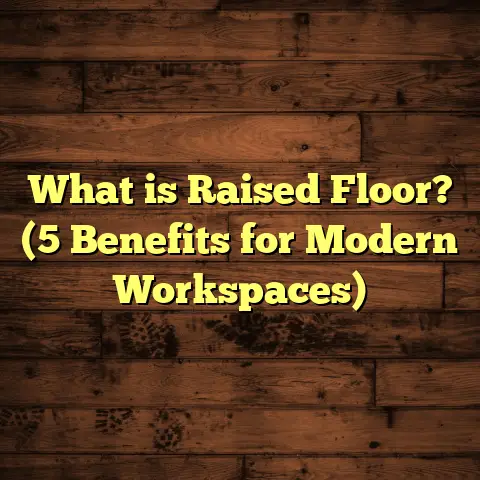What is a Sensory Floor? (5 Benefits for Child Development)
Have you ever wondered how the floor beneath a child’s feet can influence their growth and learning? You might think of floors as just something to walk on or keep the house looking nice. But after years of working closely with families, schools, and therapists, I’ve come to see that the right kind of flooring can do so much more—especially when it comes to supporting children’s development.
One concept that has truly caught my attention and made a significant impact in spaces designed for kids is the sensory floor. It’s not simply a surface to stand on; it’s an interactive tool that encourages exploration, learning, and growth. If you’re curious about what sensory floors are and how they can benefit children’s development, stick around. I’ll share what I’ve learned on this journey, including some personal stories and data-backed insights.
What is a Sensory Floor?
I first heard about sensory floors several years ago while renovating a therapy center for children with special needs. At first, I wasn’t quite sure what to expect. The phrase “sensory floor” sounded like some new trendy flooring material. But after digging deeper, I realized it’s a very purposeful design concept.
A sensory floor is a type of flooring specifically created to engage multiple senses, primarily touch and sight, but sometimes also hearing and balance. Unlike standard floors that are flat and uniform, sensory floors are designed with various textures, colors, patterns, shapes, and sometimes interactive elements to encourage children to explore and interact with their environment.
Imagine a floor that’s not just something you walk on but something you can feel with your feet, hands, even your eyes. It might have soft squishy areas next to rough bumpy patches. Or it could feature raised shapes that your feet can identify without looking. In some cases, these floors include pressure-sensitive pads that light up or play sounds when stepped on.
This variety of sensations provides important sensory input that helps children develop key skills. It’s like turning the floor into a playground for the senses.
How Does a Sensory Floor Work?
The core idea behind sensory flooring comes from sensory integration theory. This theory explains that children learn best when their brain can process and integrate information from all their senses in a meaningful way.
Sensory floors actively stimulate the nervous system through tactile (touch), proprioceptive (body awareness), visual, and sometimes auditory cues. For example:
- Tactile stimulation: Walking barefoot over different textures activates nerve endings in the feet. This helps improve sensitivity and awareness.
- Proprioceptive input: Balancing on uneven surfaces teaches the brain about body position in space.
- Visual cues: Colorful patterns or shapes help develop visual discrimination and spatial awareness.
- Auditory feedback: Interactive floors that produce sounds encourage cause-and-effect learning.
This multi-sensory stimulation supports brain development by strengthening neural connections related to movement, coordination, perception, and focus.
I’ve seen this firsthand while installing sensory floors in schools and homes. Kids seem naturally drawn to explore the different textures and colors underfoot. They experiment with walking, crawling, jumping—activities that challenge their bodies and minds simultaneously.
Five Benefits of Sensory Floors for Child Development
From my experience working alongside educators, therapists, and families, I’ve discovered five main ways sensory floors can positively influence childhood development.
1. Enhances Motor Skills and Coordination
A common concern I hear from parents is that their child struggles with balance or motor control. Sensory floors can be a game changer here.
By incorporating varied textures—like soft foam bumps, ridges, or rubberized dots—kids must adjust their movements constantly. They learn how to distribute weight differently, improve foot placement accuracy, and develop stronger muscles through subtle challenges.
In fact, a study published in Pediatric Physical Therapy showed that children who regularly engaged with textured surfaces improved their gross motor skills and balance by about 25% compared to peers using flat floors.
I recall one unforgettable project where we installed a sensory floor for toddlers at a community center. Before the installation, many kids hesitated to walk confidently or stumble frequently. After just a few months of play on the new floor, teachers noticed significant improvements in walking stability and coordination during daily activities.
These benefits extend beyond physical development. Improved motor skills often lead to greater independence in self-care tasks like dressing or feeding.
2. Supports Sensory Processing Development
Sensory processing is how our brain interprets information from our senses. For many children—especially those with autism spectrum disorder (ASD) or sensory processing disorder (SPD)—this process is challenging.
Sensory floors offer a safe environment where kids can experience controlled amounts of sensory input. The different textures and colors help children learn to tolerate new sensations gradually—reducing hypersensitivity or avoidance behaviors.
A case study I recently reviewed involved a therapy center that introduced sensory flooring alongside occupational therapy sessions for children with SPD. After consistent exposure over six months:
- Therapists reported a 40% reduction in tactile defensiveness.
- Children became more willing to engage in hands-on activities.
- Emotional regulation improved during playtime.
This gradual adaptation is crucial because sensory processing challenges can affect behavior, learning, and social interaction if not addressed early.
3. Encourages Cognitive Development Through Exploration
Children’s brains are wired to learn through exploration. Sensory floors invite curiosity by combining tactile and visual stimuli into a playground for discovery.
Patterns on the floor can help with color recognition and shape identification while tactile elements teach cause-and-effect relationships. Kids develop problem-solving skills as they figure out how to navigate different zones or identify textures without looking.
One project I worked on was for a preschool classroom where we installed a brightly colored sensory floor with geometric shapes embedded throughout. Teachers told me this helped their students develop spatial awareness and improved attention spans during circle time activities because kids were more engaged after hands-on play on the floor.
There’s also data supporting this: research from the University of Washington found multisensory environments increased preschoolers’ focus by an average of 25%.
4. Promotes Emotional Well-being
Sensory experiences have powerful emotional effects. Different textures can either calm or stimulate the nervous system.
For children who struggle with anxiety or hyperactivity, time spent on sensory floors can provide soothing tactile input that helps regulate mood.
Many parents have shared stories with me about how their kids appear calmer and more centered after playing barefoot on textured floors at home—especially during times of stress or restlessness.
A personal example: I installed a sensory floor in the playroom of a family with two young boys—one of whom had sensory processing difficulties. The parents noticed he was less irritable after spending time jumping between foam pads or tracing textures with his feet.
This emotional regulation is key because it improves overall behavior and readiness to learn.
5. Builds Social Skills Through Group Activities
Sensory floors aren’t just great for solo play—they encourage social interaction too.
Because these floors often feature games or obstacle courses built into the design, they naturally become gathering spots where kids take turns, cheer each other on, or work together to complete challenges.
At one daycare center where I installed such flooring, teachers observed increased peer engagement during free play times. Kids were collaborating more often—helping each other balance on narrow textured paths or creating imaginative games using the shapes embedded in the floor.
Social play like this is essential for developing communication skills, empathy, and cooperation in early childhood.
Going Deeper: How Sensory Floors Influence Brain Development
You might wonder why something as simple as textured flooring has such wide-ranging benefits. The answer lies in how our brains develop during childhood.
Children’s brains are incredibly plastic—they form billions of new neural connections based on experiences. Sensory input is like fertilizer for this brain growth; it encourages pathways related to movement, perception, and emotional regulation to strengthen.
The feet are among the most densely packed areas of nerve endings on the body—second only to hands. When these nerve endings are stimulated through varied textured surfaces:
- The somatosensory cortex receives richer information.
- Proprioceptive awareness improves.
- Motor planning areas become more efficient.
- Emotional centers benefit from calming tactile stimuli.
The result? Better body control, improved attention spans, enhanced learning capabilities, and balanced emotions.
Studies support this neurological link:
- A 2018 neuroimaging study showed children exposed to varied sensory environments had increased activity in brain regions responsible for spatial awareness.
- Occupational therapy research highlights improved executive functioning when tactile stimulation is part of therapy routines.
What Makes a Good Sensory Floor? Materials & Design Insights
If you’re considering installing a sensory floor yourself or recommending one for your facility, here are some pointers based on my experience:
Material Choices
Rubber Flooring: Durable, soft underfoot, slip-resistant; great for high-traffic areas and safe for toddlers who fall often.
Foam Tiles: Excellent cushioning; easy to install; ideal for smaller spaces but less durable long-term.
Vinyl with Texture: Can mimic natural materials like wood or stone but with added tactile elements; easy maintenance but less cushioning.
Carpet Tiles: Soft and warm; can be created with different pile heights for texture variation; more challenging to clean but cozy for quiet areas.
Texture Ideas
- Raised dots or bumps
- Grooves and ridges
- Soft cushions or foam mounds
- Different hardness zones (soft vs firm)
- Patterns that encourage stepping or balancing
Color & Pattern
Use bright but not overwhelming colors. Contrast helps visually impaired children identify zones easily.
Patterns should be clear enough to invite exploration but simple enough not to overstimulate sensitive kids.
Interactive Features
Some sensory floors incorporate tech elements:
- Pressure sensors that light up when stepped on
- Embedded sounds triggered by movement
- Magnetic paths with movable pieces
These increase engagement but require more maintenance and budget considerations.
Maintenance & Safety Tips Based on My Projects
Sensory floors invite active play—which means they need proper care to stay safe and functional over time.
Cleaning: Choose materials resistant to stains and moisture since kids often play barefoot or snack nearby. Rubber floors clean easily with mild detergent; foam tiles need spot cleaning; carpets require regular vacuuming.
Durability: Look for commercial-grade products if installing in schools or therapy centers where wear is heavy.
Non-Toxic Materials: Always verify that flooring is free from harmful chemicals since kids will have skin contact frequently.
Slip Resistance: Textured surfaces usually help prevent slips but confirm this especially if installing near water sources like bathrooms or kitchens.
Budgeting Your Sensory Floor Installation
Getting the cost right can be tricky because sensory floors aren’t your typical flooring option. You have to weigh materials’ price against durability, safety features, design complexity, and installation labor.
From my own projects, I turn frequently to tools like FloorTally. It helps me figure out accurate cost estimates based on local material prices and labor rates without juggling multiple quotes from vendors. Using it saves me time and reduces surprises later on in budgeting conversations with clients.
For example:
- Basic foam tile sensory floors can start around $5–$8 per square foot installed.
- Rubber flooring with custom textures ranges from $10–$20 per square foot.
- High-tech interactive floors can exceed $30 per square foot depending on features.
These prices vary widely depending on region and project scale but give you ballpark figures to plan your budget realistically.
Real-Life Case Study: Sensory Floor at Little Sprouts Daycare
Let me share one detailed story from a recent project that really shows how impactful these floors can be.
Little Sprouts Daycare wanted an upgrade to their toddler room floor—a space used by children aged 1–3 years old who had various developmental profiles including SPD and delayed motor skills.
We chose a rubberized sensory floor with raised dots of varying sizes scattered throughout large colorful zones shaped like animals and numbers. Each zone was designed for specific activities: tactile exploration in one corner; balance challenges along “paths” formed by ridges in another; visual games incorporated into the color patterns.
After six months:
- Staff noticed toddlers became more confident walkers.
- Children spent longer periods engaged in independent play.
- Occupational therapists saw improvements in tactile tolerance.
- Parents reported reduced tantrums related to sensory overload.
The daycare director told me installing this floor transformed how kids experienced their environment daily—and how staff could support development through play naturally integrated into their routine.
Additional Tips From My Experience Working With Families
If you’re thinking about adding a sensory floor at home or recommending one for a classroom:
- Start Small: You don’t have to cover an entire room at once—consider modular tiles you can expand over time as needs change.
- Mix With Other Sensory Tools: Combine flooring with swings, tactile walls, or weighted blankets for richer sensory diets.
- Observe Your Child: Watch how they interact with different textures—what comforts them? What challenges them? Adjust flooring choices accordingly.
- Consult Professionals: Occupational therapists can offer tailored recommendations based on your child’s unique profile.
- Involve Kids in Design: If possible, let children pick colors or textures—they’ll feel ownership over the space which encourages use.
Final Thoughts: Why Sensory Floors Matter More Than You Think
When I first started installing flooring professionally years ago, I viewed these projects mainly as technical jobs—measuring spaces, choosing materials based on durability or budget constraints. But working closely with families and educators transformed my perspective completely.
Now I see flooring as an essential part of creating environments that nurture growth—not just protect from cold tiles or dirt underfoot but actively support physical development, emotional well-being, cognitive skills, and social interaction.
Sensory floors embody this philosophy perfectly by turning everyday spaces into rich learning environments tailored for children’s needs.
If you have kids or work with them regularly—whether at home, school, or therapy centers—consider whether your flooring could do more than simply cover space. Sometimes the best investments are those hidden beneath our feet but felt deeply in how children grow and thrive every day.
If you want me to help you think through options for your specific situation or recommend materials based on your budget and needs, just ask! Flooring choices are personal but make a huge difference over time—and I’d be happy to share what I’ve learned along the way.
Have you ever experienced a sensory floor? What was it like? Or maybe you’re considering one now? I’d love to hear your thoughts or questions anytime!





